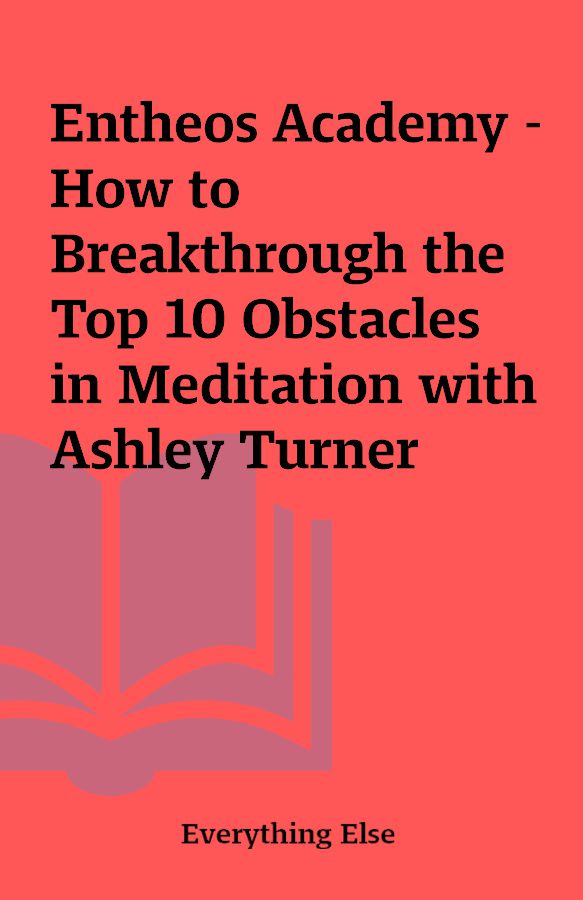Entheos Academy – How to Breakthrough the Top 10 Obstacles in Meditation with Ashley Turner
How to Breakthrough the Top 10 Obstacles in Meditation.mp4
[WebRip – 1 MP4]
Description
Class OverviewWe all know that meditation is good for us, but after starting it’s easy to slide off after not seeing immediate results. Ashley will explain how to show up consistently and the benefits for the mind. (Check out the Top 10 Big Ideas from the class below!) Your ProfessorKnown as an innovator in holistic health, Ashley bridges yoga-meditation, psychology and neuroscience. She is the creator best-selling yoga dvds, co-author of Aroma Yoga and an Ordained Priestess. How to Breakthrough the Top 10 Obstacles in MeditationIn beginning a meditation practice, there are common (almost universal) challenges that arise. Some of these have to do with common “myths” of meditation. Others are common negative habit patterns of the mind – “mind traps”. If we are not aware of these – we may become easily discouraged and feel like quitting. Once we “normalize” these tendencies, realizing they affect nearly everyone, we can learn how to work with them and even use them as support in our practice. To Begin….The 5 MYTHS OF MEDITATION The Top 10 Big Ideas1 “In Meditation, My Mind Should Be Calm and Quiet” One of the most common myths of meditation is that it’s about “getting rid of thoughts” and experiencing a calm, quiet mind. Meditation is actually about noticing how our mind works, observing the rapid-fire thoughts neutrally and not getting caught up in them. Meditation is a training of the mind. We train our mind to notice when we get caught up and come back to the present moment. We can still be meditating while we are in the presence of thought. 2 “I Don’t Have Enough Time to Meditate” Remember, mindfulness is a kind of meditation – simply being aware of what we are doing in any moment (walking the dog, doing the dishes, talking on the phone). It is building awareness in the present moment – simply being aware of the sensations, thoughts and emotions that arise. We can do this anytime, anywhere. While the most effective way to build momentum is to sit for a regularly designated sitting meditation, however, even 5 minutes a day or pausing for 10 deep breaths is extrememly helpful.3 “It Feels Like My Mind is More ‘Crazy’ During Meditation” Once we pause and start paying attention to our mind, we begin to see how erratic and addictive it is and how little control we actually have over it. It can be disturbing to realize how unruly our mind is – but, remember, meditation is a practice of paying attention. So, making this observation is a sign of progress, not failure. 4 “Meditation Should Be Blissful, But If Feels Like Such Hard Work” The mind is a mirror. When we begin to meditate, we are faced with thoughts and emotions that may be painful or difficult to experience.Meditation can be difficult, tiring and even frightening. It is not easy to sit still with unpleasant patterns arising. We usually see pictures and images of people meditating – sitting in a serene, blissful state. Over time, by bringing our thought and emotional patterns into awareness, we begin to learn how to work with them and release them. And, meditation will become easier and more blissful. 5 “I Don’t Think Meditation is Working For Me….I’m Not Seeing Any Results Yet” Like life, our meditation practices will unfold in it’s own time and at its own pace. Meditation can help heal emotions, change thought patterns and create more responsive, less impulsive behavior….but, it doesn’t happen overnight. Studies show that positive neurological changes and neural integration can occur even within the first few meditation sessions. Consistent, even small, effort is more effective than sporadic, longer, enduring sitting meditation. When we don’t notice life-changing, blissful experiences…we may get discouraged or even feel like quitting. Instead of focusing on how blissful you feel during meditation or how long you can sit, focus on any small changes in your daily life: •Are you sleeping better?•Are you feeling a bit more positive, motivated and upbeat about life?•Are you more able to ‘let go’ of stressful thoughts or impulsive reactions? These are signs that your meditation practice is working. And now…on to: THE 5 MIND TRAPS OF MEDITATION 6 Negative Self Talk (“Self–Beat”) Negative self–talk is one of the greatest traps of the mind. For most of us, the greatest battles we will ever face is in our heads. We say things to ourselves that we would never dream of saying to others. We can be downright abusive and cruel: “You’re no good.” “You’ll never succeed.” “You’re not good enough.” As with all the mind traps, noticing the self-beat is the first step to overcoming it. Honestly inquire, “Is this thought absolutely true?” We can always find examples of the contrary. We can begin to “flip the switch” and turn these statements into positive self–talk. When we recognize these are just passing, uncomfortable thoughts and not reality, they will begin to pass on their own and hold less influence. 7 Exaggerating the Negative + Discounting the Positive The mind tends towards the negative. This is a more generalized version of Negative Self Talk. We habitually criticize people, events, places – either in our minds or out loud to others. Or, we may say something positive, but then follow it with, “but, ….” and twist the truth to discount the positive and emphasize the negative. Putting the world or others down, is a false attempt to make ourselves feel better in comparison, but in reality, this mind trap reinforces our feelings of insecurity, anxiety and depression. 8 Blaming Blaming keeps us perpetually disempowered. It stems from a mind that is so insecure it can never admit it makes mistakes. This mind trap always looks to place the blame for our circumstances and even feelings on another. It arises out of other mind traps such as “The Need to Be Right” or “The Should’s”. Until we take full responsibility for every experience in our lives, we will remain insecure and dis-empowered. When we realize we have the power to affect change and create our lives, we gain courage and confidence. 9 Catastrophizing When the mind focuses on the future and assumes the worst possible outcomes, it slips into it’s self–imposed, somewhat narcissistic, drama queen. Catastrophizing fuels our anxiety, fear and panic. This style of thinking is a type of self–entertainment. It is a habit to avoid the discomfort, boredom or uncertainty of simply being present and waiting to see what unfolds. This can often (like all the mind traps) be heavily influenced, learned and reinforced by parents or a culture that emphasized drama, excitement and negativity. 10 The “Should’s” My priestess, Ariel Spilsbury tells a story of the “Should Bird”, who sits on our shoulder, nastily chirping all the “Should’s” in our ear….and “Should-ing” all over us. Meditation helps us reduce this bird “sh*&t”. We identify the inner voices that hold us back, limit our options and constantly keep us bound in comparison to others. When we break the rules we set for ourselves by internalized voices of parents, teachers and society, we feel guilt and shame. When others break these rules, we tend to judge them, feel anger or resentment.
You must be logged in to post a review.






Reviews
There are no reviews yet.